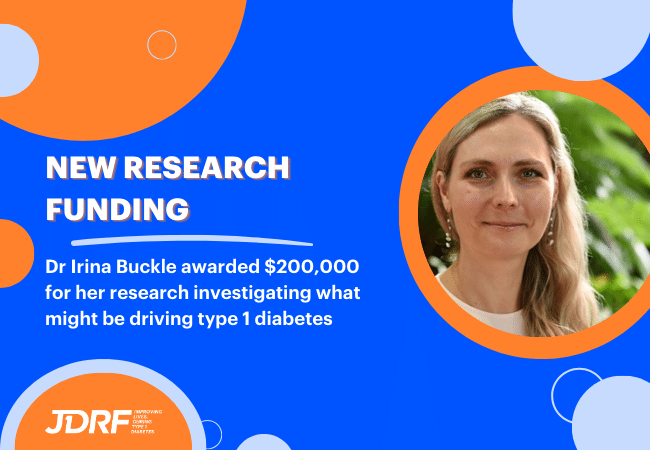Exercise and Type 1 Diabetes: World-First Guidelines Consensus
A report by leading type 1 diabetes experts
(T1D) from around the world has for the first time, provided consensus on managing blood glucose levels safely while exercising.
The report, ‘Exercise management in type 1 diabetes: a consensus statement’ was published in the Lancet Diabetes and Endocrinology journal and involved a team of 21 researchers, including JDRF Type 1 Diabetes Clinical Research Network (T1DCRN) researchers Professor Tim Jones, Professor Paul Fournier and Dr Carmel Smart. The team undertook a review of current published studies to understand the activity levels of those living with T1D and how different types of exercise affect blood glucose levels.
The study found that a large number of people living with T1D worldwide do not have a healthy body weight or achieve the minimum recommended exercise of 150 minutes per week. Many people find managing their condition while exercising to be difficult, and they might avoid daily physical activity because of this. Delayed low blood glucose levels after exercise is a common fear, as well as loss of control and lack of knowledge.
Healthcare professionals should encourage and support regular exercise for many reasons, but primarily because the overall health benefits outweigh the immediate risks if certain precautions are taken.
Research has shown that children and young people with T1D who exercise regularly have reduced cardiovascular disease risk, reduced HbA1c (a marker of long term glucose control) and improved body composition, blood vessel function and cholesterol levels. Adults with T1D benefit from reduced eye and kidney damage and have better chance of achieving their BMI, HbA1c and blood pressure targets compared to inactive people. Importantly, regular exercise also decreases total daily insulin needs.
Some of the findings and recommendations from the report include:
- For everyone with T1D, glucose monitoring before, during and after exercise is essential.
- A blood glucose level of between 7-10mml/L before beginning exercise is generally recommended, to help to protect against hypoglycaemia.
- Responses of blood glucose levels differ according to the type of exercise. It is important to understand the differences between exercises when planning food.
- Hypoglycaemia develops in most people with T1D – both those who regularly exercise and those who don’t – within 45 minutes of starting cardio exercise. All typically required a carbohydrate snack or insulin reduction, or both, before exercising.
- The risk of hypoglycaemia is also increased 24 hours after exercise, with the greatest risk of night-time hypoglycaemia occurring after afternoon activity.
- Foods with a low glycaemic index before exercise could sustain carbohydrate availability in the body and maintain normal blood glucose levels. Sports beverages containing carbohydrates and electrolytes are useful for athletes with T1D who are exercising for a longer duration, as it provides a hydration and fuel source, while preventing hypos.
- Different people exercise for different reasons. When managing T1D, exercise for weight loss will require strategies that focus on reduction of insulin as opposed to extra eating, whereas if the aim is to increase fitness performance, then nutritional guidance specific to the sporting activity is needed.
- People on insulin pumps are able to more quickly manipulate their treatment when exercising, as they can manually reduce their basal insulin by suspending or reducing the amount on their pump. The team found that when basal insulin was modified, the effect was seen within one to two hours. Suspending basal insulin one hour before exercise reduces the risk of hypos but may increase the risk of hyperglycaemia after exercise.
Blood glucose responses to exercise in individuals with T1D are highly variable and influenced by the location of insulin delivery, the amount of insulin in circulation, the blood glucose concentration before exercise and the composition of the last meal/snack, as well as the intensity and duration of activity. These guidelines therefore do not have a one-size-fits-all approach and people with T1D should speak to their healthcare professional to get individualised advice on how to safely incorporate exercise into their daily routine.
The research team hope these new recommendations for exercise management will encourage more people with T1D to increase their exercise levels.
The JDRF Type 1 Diabetes Performance in Exercise and Knowledge (PEAK) Program will roll out in Australia this year, where healthcare professionals from around the country will meet to update their knowledge on managing exercise and T1D. This will ensure they are relaying the most accurate, up to date information to their patients.
The authors made some important findings and recommendations, however note that these are based on a small number of available studies. This report recognised the need for more studies on exercise and T1D that determine how to best prevent exercise induced hypoglycaemia with basal rate insulin dose adjustments and how to manage glucose levels in the recovery period after exercise. Here is Australia, the T1DCRN is funding a clinical trial, led by Associate Professor Liz Davis in WA, that aims to address gaps in current guidelines with specific trials on the effects of different types of exercise and food on blood glucose levels in people with T1D.




